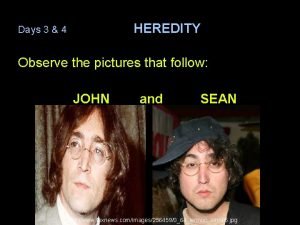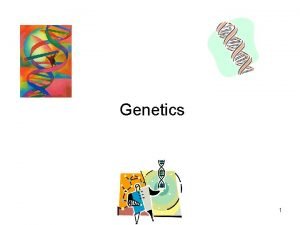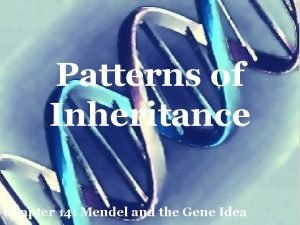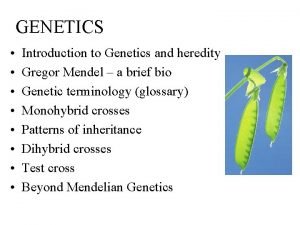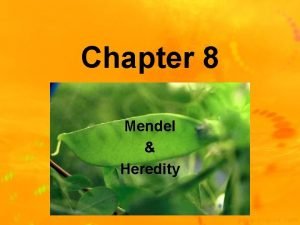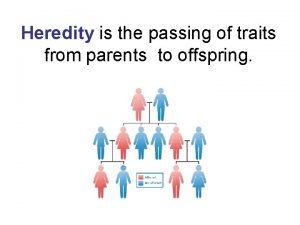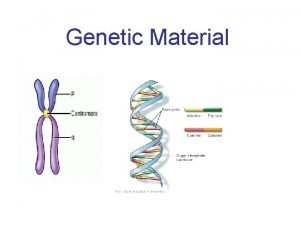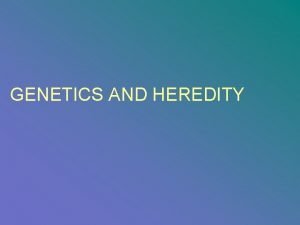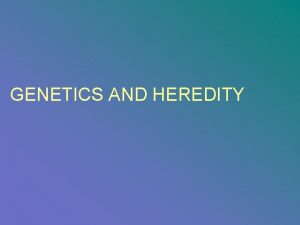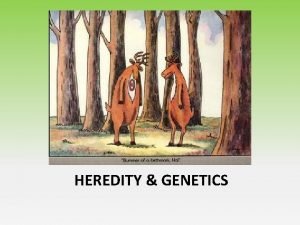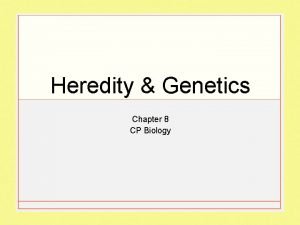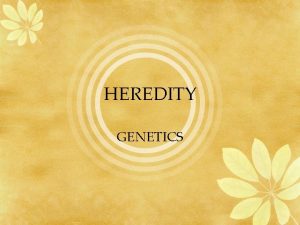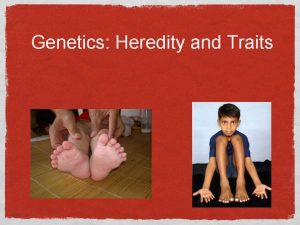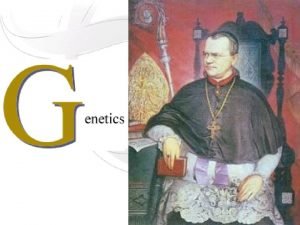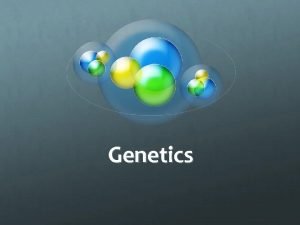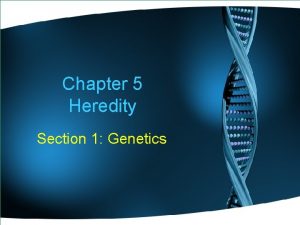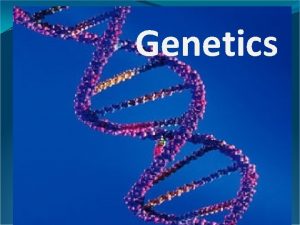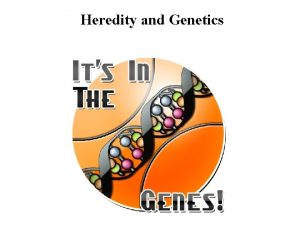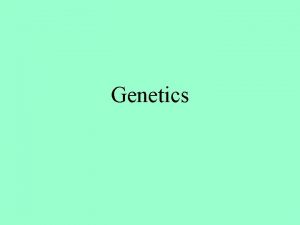Heredity Genetics What is Heredity l Heredity is
















- Slides: 16

Heredity & Genetics

What is Heredity? l Heredity is the passing of traits from parent to offspring. l You inherit traits from your parents

What are traits? l Eye Color l Hair Color l Height l Weight l Body Structure l Facial Features l Skin Color

What traits did you inherit from your parents? l. I have my dad’s toes and my mom’s nose…what about you?

How are traits passed? l When organisms reproduce, traits are passed from parent to offspring. l These traits are carried in DNA, the genetic material found in a cell’s nucleus.


Each parent passes one set (23 of their 46) chromosomes to their offspring. l The offspring now has 23 matching pair (one set from each parent) l Each chromosome contains genes (ex: eye color). Specific codes of DNA on that gene location are called ALLELES (ex: blue, brown, or green eyes). l


Dominant & Recessive Genes l Remember, you have two copies of each gene that you inherited from your mother and your father. l Each copy of the gene could be different. – For example one copy may give you blue eyes while another may give you brown. l So, what color are your eyes if you have both the brown and blue eye version of the eye color gene? Brown. l This is where the idea of dominant and recessive comes in. Dominant means that one of the versions trumps the other. In our example here, brown is dominant over blue so you end up with brown eyes.

Dominant & Recessive Genes l The way people write out dominant and recessive traits is the dominant one gets a capital letter and the recessive one a lower case letter. – B (capital) = Dominant – b (lowercase) = Recessive l So for eye color, brown is B and blue is b. As I said above, people have two versions of each gene (1 from mom and 1 from dad) so you can be BB, Bb, or bb. – BB and Bb = brown eyes (Dominant) – bb = blue eyes (Recessive)

GENOTYPE vs. PHENOTYPE l Genotype = Genetic makeup – EX: TT, Tt, rr, Rr, Ww, ww, EE l Phenotype = The way an organism looks and behaves as a result of the genotype – EX: Tall, wrinkled skin, Red, Wavy tail, Bare tail, Large ears

Name a genotype…w hat is the phenotype?

Alleles Determine Traits l Organism with two alleles that are the same = Homozygous TT (dominant, tall) l tt (recessive, short) l l Organism with two different alleles = Heterozygous l Tt (dominant, tall)

GREGOR MENDEL l The study of heredity started with the work of Gregor Mendel and his pea plant garden. l Gregor Mendel is considered to be the “Father of Genetics. ”

Who was Gregor Mendel? Gregor Mendel was born in 1822 in Austria. l He grew up on his family’s farm and was able to learn a lot about flowers and fruit trees. l After going to college, he joined a monastery. At the monastery, he worked in the garden where he studied how traits were passed form parent to offspring. l He grew many generations of pea plants and study probability of seven different traits. l

What Mendel Discovered? l 1. Traits are controlled by alleles on chromosomes l 2. An allele’s effect is dominant or recessive. l 3. When a pair of chromosomes separates during meiosis, the different alleles from a trait move into separate sex cells.
 Chapter 17 the beginning of the life cycle
Chapter 17 the beginning of the life cycle Genes is the study of heredity and variation
Genes is the study of heredity and variation Pictures of heredity
Pictures of heredity Heredity acrostic
Heredity acrostic Dice and coin
Dice and coin Cpalms heredity
Cpalms heredity Heredity torrent
Heredity torrent Inheritance vs heredity
Inheritance vs heredity Chromatids
Chromatids Section 3 mendel and heredity
Section 3 mendel and heredity Heredity
Heredity Mendelian genetics vocab
Mendelian genetics vocab Flower structure
Flower structure The basic units of heredity
The basic units of heredity Allele
Allele Genetic vocabulary worksheet answer key
Genetic vocabulary worksheet answer key Heredity
Heredity


